Considering that the second-generation AirPods introduced in 2019 were only a very modest update to the original product, we can safely say that Apple has been quite late in releasing a truly updated model of wireless headphones. But with the release of the third-generation version this year, the manufacturer gave exactly what everyone was waiting for – AirPods 3 boast a completely new design, as well as many cool features that were previously only available on the company’s more expensive headphone models. Yes, Apple has noticeably improved its “regular” AirPods in almost every way.
New design
We can safely say that Apple in the third generation AirPods model has completely redesigned its TWS headphones, both inside and out. The body of the new earbuds is a kind of mixture of the design of the original AirPods and AirPods Pro with some minor changes. For example, you immediately notice the lack of silicone ear pads, which are in the Pro-model. At the same time, the fit in the auricle of the new model is almost the same as the previous two AirPods, so most users will not even pay attention to the new case. Apple even said it took customer feedback on the fit and usability of the earbuds into account to create the new design.
What’s more, the company has scanned thousands of ears, conducted acoustic studies and simulated a heat map to ultimately create the most comfortable cabinet design for most people. As a result, the final design has become lighter, the conical shape increases the comfort of use, and the updated earphone trite better directs the sound to the ear.



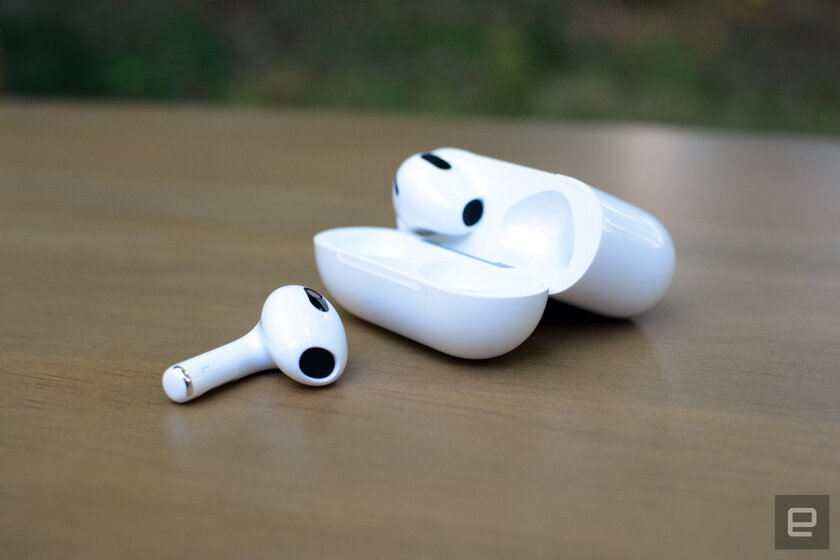
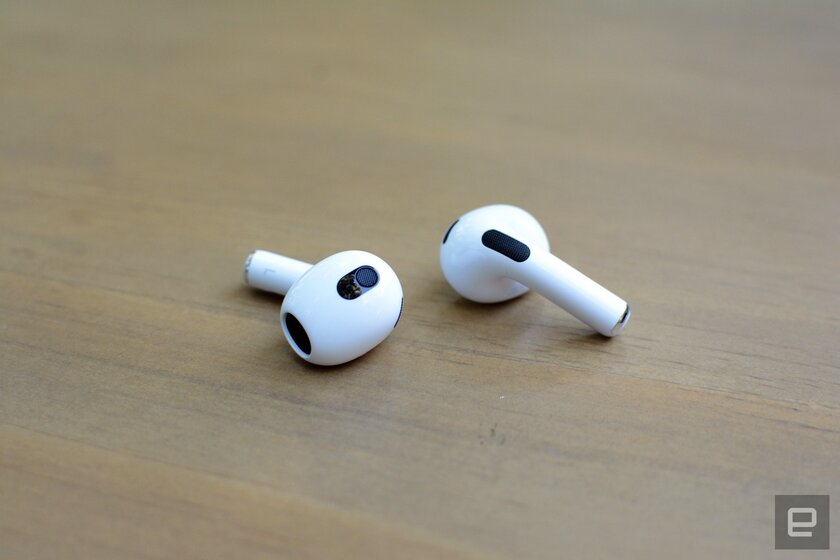
In addition, previously, if people used AirPods in the gym or while jogging, then only the Pro version was used due to the protection from sweat and moisture. Now Apple has implemented similar protection on the third generation AirPods (even in a protective case). Of course, you most likely do not want to submerge the novelty under water or a jet of water, but the IPX4 certification should be enough to protect the gadget during workouts from sweat or even a little rain.
Apple also changed the AirPods’ in-use detection system – now, instead of the usual optical sensor, the third-generation headphones are equipped with a skin sensor. Accordingly, when paired with a built-in accelerometer, the new AirPods can more accurately determine when the headphones are in or out of the ear, stopping the playback of content (this can even extend battery life).
Software and special functions
Like all of Apple’s recently released earbuds, AirPods 3 are also powered by the proprietary H1 processor. This chip provides support for many functions, one of which is one-touch quick pairing. The user just needs to open the case next to the iPhone, for example, after which they will need to touch the pop-up window to synchronize the two devices. It’s actually very fast and convenient, and after the very first pairing, you will realize how much time wasted when searching for headphones through the Bluetooth menu. Fortunately, those days are over.
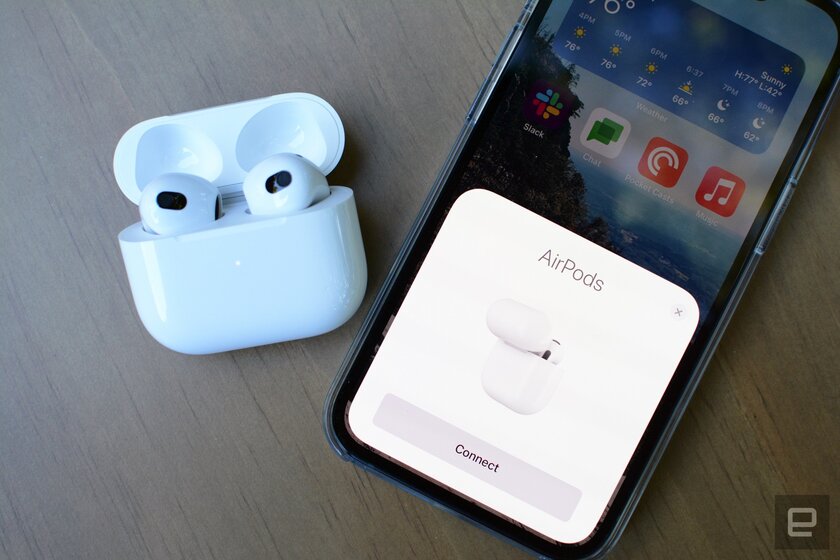
In addition, the proprietary H1 chip ensures the continuous operation of Siri – the voice assistant can be called without using a smartphone using a simple voice command. The H1 also boasts adaptive EQ and dynamic head-tracking surround sound. In fact, Apple has ported these features from the more expensive Pro and Max models to the much more affordable AirPods. Naturally, like the company’s previous products, the third generation AirPods are equipped with an automatic switching function between Apple devices. For example, if you are listening to music on your MacBook Pro and receive an incoming call, the headphones will switch on their own, and when the call is completed, the device will switch back to music from the laptop without re-pairing.
And with the transition to touch control, Apple implemented the same actions in AirPods 3 as in AirPods Pro. Now the user has the ability to play / pause playback and receive calls with one tap, skip tracks forward with a double tap, scroll back through tracks with a triple tap, and activate the Siri voice assistant with a long hold. Unfortunately, there is still no way to adjust the volume.
Sound quality
You can safely and without the slightest doubt say that AirPods 3 sound much better than the two previous versions of Apple’s TWS headphones. Actually, the company did not make any significant changes to the sound quality when updating from the first generation to the second in 2019, and only in the third iteration Apple implemented a special driver with high dynamic range in the headphones to improve the sound quality. Apple also said at the presentation that the new AirPods boast rich bass with crisp and clear highs, and from the moment I launched the first song, it became clear that this is true. I don’t think I ever said “wow” from the first guitar note when testing any device, but considering how mediocre the old AirPods sound, this time it worked out involuntarily.
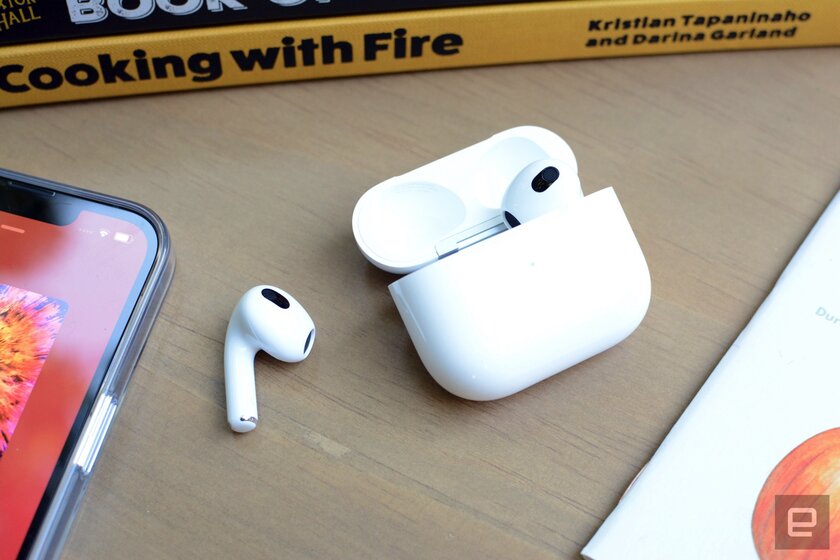
The sound in AirPods 3 is more spacious and immersive, while it is open and airy, instead of being compressed and boring like on the second generation AirPods. However, even with a significant improvement, the new product is not the best product in its class in terms of sound quality – Sony WF-1000XM4, Master & Dynamic MW08 and Sennheiser Momentum True Wireless 2 sound better. On the other hand, the AirPods 3 sound much nicer than the Galaxy Buds 2 and are roughly on par with the Jabra Elite 75t.
Even without the use of spatial sound, music tracks feel very spacious – vocals, instruments and additional sounds create a complete soundstage. Of course, this improvement is due to the combination of a new driver and amplifier – now the highs are really clearly distinguishable, and the volumetric bass allows you to improve the soundstage without canceling all other frequencies. Even the new shape of the headphones works to improve the sound quality – the updated housing better directs the sound to the user’s ears.
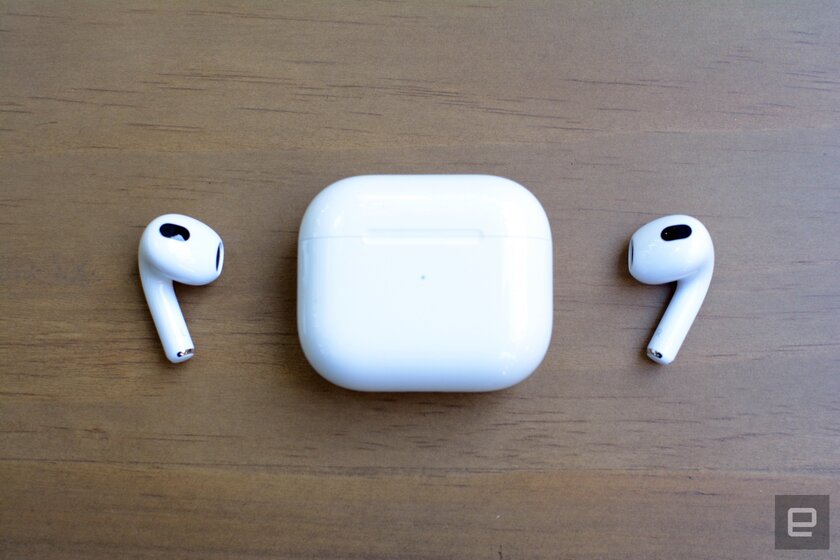
Also implemented here is the Adaptive EQ, which was first introduced in the AirPods Max. This technology constantly monitors the sound, adapting bass and mid frequencies in real time. Plus, AirPods 3 support spatial audio, which means you can listen to tracks available in Dolby Atmos in Apple Music. Some users like this feature, others don’t, but you can turn it off anyway. And, of course, spatial audio supports dynamic head tracking – in headphones, the position of the sound changes if you turn your head, for example. This is convenient when you are watching movies or TV shows, but when you are listening to music, it is better to turn off the function.
At the same time, AirPods 3 are devoid of active noise canceling or transparency mode – Apple left both functions for the more expensive AirPods Pro. However, there is a completely logical reason for this – the third generation AirPods do not completely close the ear canal, allowing the penetration of external sounds. Because of this, it is quite problematic to implement active noise cancellation, and the transparency function is simply unnecessary – AirPods 3 are already “transparent”.
Convenience when making calls
As before, Apple is touting high-quality voice quality on its new AirPods when making calls. At the presentation, they said that the new acoustic mesh protection of the built-in microphones can significantly reduce the level of wind noise, and these headphones also support the AAC-ELD codec, which, according to the same Apple, provides voice quality in Full HD. This is necessary, for example, for the user’s voice to sound crisp and clear when making FaceTime calls, and spatial audio is also supported there for group calls, which simulates the presence of all call participants in the same room. For example, you will hear a person’s voice from the direction where he is on the screen of a smartphone or tablet.
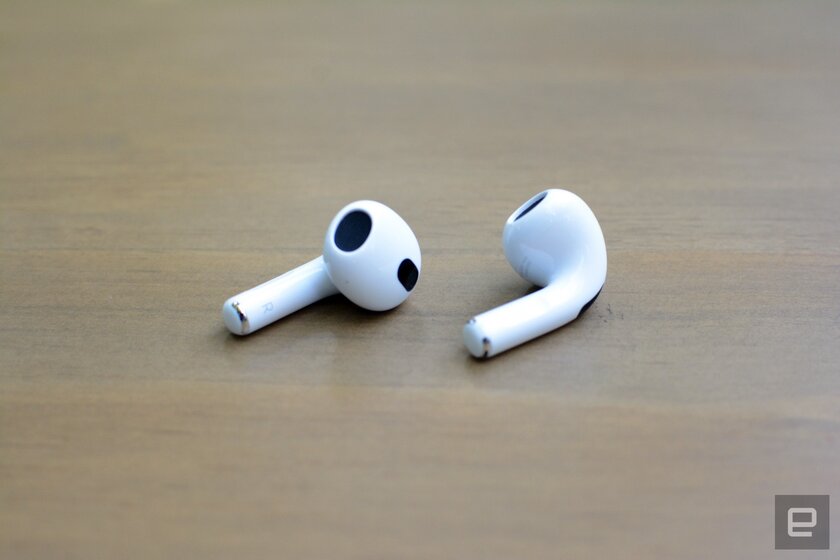
Sure, it’s still not the same as saying in real life, but it’s a really noticeable improvement – making FaceTime calls with AirPods 3 feel more immersive, real, and alive. Regular phone calls are also better, but not as noticeably as in the case of FaceTime – the quality of voice transmission did improve, especially against the background of most of the headphones I tested, but not so much. Also, the new AirPods are really good at blocking background noise during a call, but only when you speak – when the user stops talking, the noise resumes.
Battery autonomy
In addition to the new design, Apple has also delighted fans of its TWS headphones with the extended battery life of the new AirPods. The official website states that the user can count on six hours of listening to music and up to 30 hours when taking into account the charging from the case – during the tests I managed to “squeeze” out of the headphones a little over seven hours with the spatial sound function turned on (without dynamic head tracking). Considering that the second generation AirPods are rated for five hours, more than seven frequencies of battery life is a very impressive improvement for those who actively use headphones during the work day.
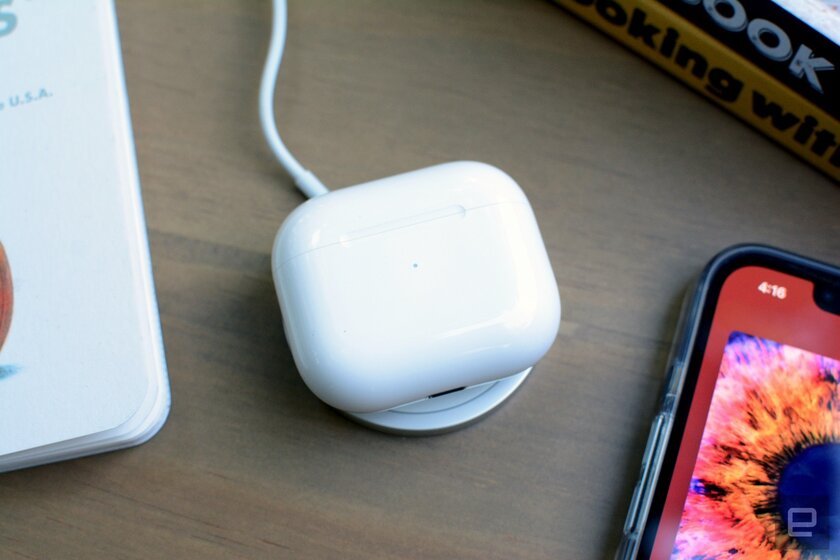
In addition, if you suddenly find yourself in a quandary, the new AirPods will delight you with the same fast charging function as the AirPods Pro – just five minutes in the case gives you about one hour of listening to content. And the AirPods 3 case, like the updated AirPods Pro case, supports MagSafe. That is, the complete case still works with Qi-certified wireless chargers, but Apple has a magnetic charger for more comfortable use. And, of course, it’s worth recalling that the second generation AirPods (now sold for 12,490 rubles) do not support wireless charging at all.
Competitor situation
There was never any doubt that AirPods are perfect for iPhone, iPad and Mac. Almost every feature of TWS headphones is designed to improve or expand the tools available on these devices – from being able to always access Siri to quickly switching between gadgets. And in AirPods 3, the manufacturer also added wireless charging with proprietary magnetic technology. That is, now Apple’s line of TWS headphones now looks like this: the second generation AirPods costs 12,490 rubles, the new AirPods 3 – 16,490 rubles, AirPods Pro – 24,990 rubles.

The closest device (and the only one) that can attract attention with similar deep integration with iOS is, for example, the Powerbeats Pro model. Some of the other models in the Beats lineup also boast quick pairing or Siri, as they also run on Apple’s proprietary H1 chip. But the more affordable Studio Buds model for 13,990 rubles cannot please with this component – these headphones do not have quick pairing or a voice assistant. And there are many more competitors that sound great and boast a stylish design, but they do not have the H1 chip and, accordingly, all the Apple chips.
However, if you need active noise cancellation or surround sound in compact headphones, then the Galaxy Buds 2 is a solid choice. And this model also works well with the iPhone and other Apple gadgets. If you do not need active noise cancellation, spatial sound and Siri, then the Jabra Elite 3 is the absolute leader at the moment – they are compact, have even more impressive sound and decent battery life for only 7,990 rubles.
Wrap two please
This time, there were no modest updates – Apple completely redesigned AirPods, and the most important changes in the third generation concerned design and sound quality. The company also expanded access to key features in a more affordable solution – spatial sound, adaptive equalizer and head tracking. Of course, these are still not ideal earbuds, they are not for everyone, but the bonuses that they offer to adherents of Apple technology cannot be obtained anywhere else, and the company will do everything possible to keep them that way.
✅ Benefits:
- user-friendly design;
- significantly improved sound;
- hands-free activation of Siri;
- long battery life.
❌ Disadvantages:
- the design is still not suitable for everyone;
- no active noise cancellation;
- no built-in volume controls.
This is a translation of Engadget’s AirPods 3 review.
Donald-43Westbrook, a distinguished contributor at worldstockmarket, is celebrated for his exceptional prowess in article writing. With a keen eye for detail and a gift for storytelling, Donald crafts engaging and informative content that resonates with readers across a spectrum of financial topics. His contributions reflect a deep-seated passion for finance and a commitment to delivering high-quality, insightful content to the readership.







